Shein Versus the Mall

Key Takeaways
The 2000s mall brand rebound is particularly notable among millennials. For example, Abercrombie’s net purchasing consideration rose 5.9 points from the first quarter of 2021 through the last quarter of 2024.
While the mall fashion brands were popular two decades ago, Shein’s more recent entry into the U.S. market sees faster growth and stronger consideration among key audiences like Gen Zers.
Shein is particularly popular among Gen Z women in urban communities who use the ultra-fast fashion e-commerce site to stay on top of apparel trends.
Download our new report, The State of Apparel, for a deep dive into key shopping trends in the apparel industry.
The rise in popularity of 2000s mall brands like J.Crew and Abercrombie & Fitch is a strong case study for brand revivals. Capitalizing on a brand’s legacy while reinventing itself for a new generation is a hard needle to thread, but a few have managed it. These mall brands left standing in 2025 have re-engaged with millennials, their former core audience, and also found new shoppers in Gen Z.
At the same time that these brands are working to stay ahead of trends, ultra-fast fashion brand Shein continues to take the U.S. apparel market by storm. Shein’s low cost offerings allow consumers to participate in trends without a big financial outlay, and appeal to consumption-centric youth culture in a way that is hard for legacy brands to compete with. These connected if competing trends paint a picture of what’s in store for the U.S. apparel sector in 2025.
Mall brands are making a comeback, particularly among millennials
A few exemplar mall brands from millennials’ youth (Abercrombie & Fitch, Gap, J.Crew and Victoria’s Secret), are all rebounding in purchasing consideration with those same customers. That success is built on a foundation of modernizing business practices as well as identifying what part of their roots should carry forward, and what needs to stay in the malls of the early 2000s (like the dim lighting and overwhelming fragrances many of us would like to forget).
Some of these brands are also finding relevance with Gen Zers. Abercrombie’s purchasing consideration among Gen Z has risen as well, as the brand taps into trends relevant for a younger generation. In 2024 the brand launched a wedding shop for bridal events, targeting Gen Z’s important milestones.
Purchasing consideration among 2000s mall brands is rising, particularly among millennials

That resurgence is not without bumps: Purchasing consideration for all brands dipped in mid-2022 when inflation hit 9%. For some, their past came back to haunt them. Spring and summer 2022 also saw documentaries about Abercrombie and Victoria’s Secret’s past brand mishaps, leading to more dramatic swings in consideration.
Shein’s purchasing consideration tops that of mall brands
In 2024, apparel retail saw competing trends: Shein’s purchasing consideration rose right alongside those mall brands. The 2024 Fastest Growing Brands report, a ranked list of the brands with the largest rise in purchasing consideration across the year, saw Shein rank 12th among women, with Abercrombie & Fitch ranking 20th among middle-income shoppers, and Victoria’s Secret ranking 20th among financial elites.
While purchasing consideration for the mall brands included in this analysis has been trending upward since the summer of 2022, Shein’s offering as a low-cost fast fashion source has stayed consistently more popular.
Shein’s purchasing consideration continues to rise among Gen Zers

Much of that popularity is driven by Gen Zers, who enjoy mall brands more than the average consumer, but are taken with Shein’s ability to offer trendy styles in a timely fashion at extremely competitive prices. Gen Z is clearly not fully ignoring the controversies surrounding the brand, including accusations of IP theft and inhumane labor practices, as the e-commerce giant’s purchasing consideration among Gen Zers fell to its lowest point with the generation when an influencer factory tour backfired. TikTok users’ For You Pages were inundated with criticism, but that seems long forgotten now.
Shein’s shoppers are younger and more likely to be female
Shein isn’t strictly appealing to Gen Zers — 38% of their customers are millennials, compared to 31% for Gen Zers, per data from Morning Consult Intelligence. Mall shoppers are also mostly millennial, at 36%. After all, these brands captured the attention of that generation not once, but twice.
Shein’s shoppers tend to be younger women in urban areas

Mall shoppers’ gender split aligns with the general population, but Shein shoppers are more likely to be women. Urban dwellers are more likely to shop from both mall brands and Shein, consistent with a more common general preference to dress on-trend.
Lower-income shoppers (a larger share of the population overall) take advantage of Shein’s lower prices at high rates, while middle- and high- income shoppers have slightly outsized representation among mall brand shoppers.